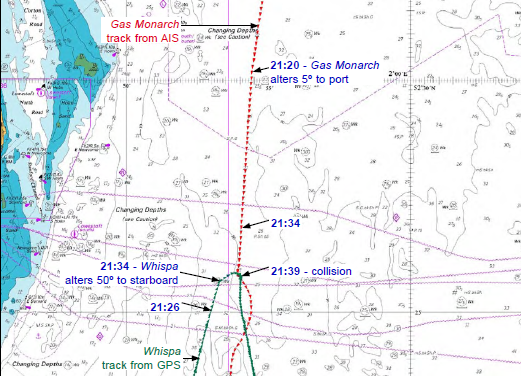A Seamanship Challenge – What would you do?
Radar Assisted Collision – the risk
This true story is taken from an MAIB report, YM article and discussion between professional seafarers. Further reading, arithmetic and layout with paper and compass is valuable.
The Liquefied Petroleum Gas (LPG) carrier, Gas Monarch, collided with the sailing yacht, Whispa, in dense fog 6 miles ESE of Lowestoft.
Gas Monarch was proceeding at full speed, in fog, when her master left the bridge in the hands of his third officer (3/O) and an able bodied seaman (AB), contrary to his own standing orders. Whispa appeared out of the fog on a crossing course at very short range. Evasive action by both craft was unsuccessful and the vessels collided.
Prior to the collision, the 3/O on Gas Monarch had detected Whispa by radar and had calculated that the contact would pass clear to starboard. Gas Monarch lost Whispa’s radar contact at a distance of just under 3 miles, but carried on at full speed with no sound signals in the dense fog.
Whispa was motoring on her auxiliary engine with her skipper on watch and his crew member resting below. The yacht skipper had detected Gas Monarch by radar and monitored the target track close to his radar heading marker, for several miles. Whispa’s skipper had limited knowledge of his radar’s capabilities or limitations; without plotting, calculating a closest point of approach (CPA), or establishing Gas Monarch’s speed he concluded that the vessels were on a collision course. Whispa made a bold alteration to starboard when the vessels were just over a mile apart (and closing at fully 18 knots) but this action, instead of moving Whispa clear of Gas Monarch, brought the two vessels onto a collision path.
Gas Monarch’s bow struck Whispa’s port transom and rudder, slewing the yacht round to port and pushing her clear, which allowed the vessels to pass without further contact.
Gas Monarch did not slow the ship. Hearing Whispa’s distress call stimulated him into calling the master, who rushed to the bridge, immediately stopped the ship,
Pre-collision: Gas Monarch
At 2118 Gas Monarch was proceeding on autopilot at full sea speed before a 2kt tidal stream, making good about 14.3kts, when Whispa was acquired as a radar contact at a range of just over 6 miles. After briefly observing the radar contact for a few minutes, when the radar contact was being displayed ahead of Gas Monarch at a distance of 7
about 5.5 miles (Figure 4), the 3/O altered 5º to port to create a starboard to starboard passing situation. By appraising the contact’s radar trails, the 3/O estimated the resulting CPA would be approximately 1nm on Gas Monarch’s starboard side. As the vessels closed to 3 miles (Figure 4), the trails of Whispa’s radar contact indicated to the 3/O a reduced CPA of 0.7nm to starboard. When the vessels were just less than 3 miles apart, the yacht’s radar contact was lost from both radar screens of Gas Monarch.
Pre-collision: Whispa
Whispa’s skipper first became aware of Gas Monarch as an unidentified radar target appearing at the edge of his radar’s 6-mile range scale, fine on the port bow. At this stage he believed the range rings being displayed on the radar screen were set at 1-mile intervals. He did not plot the contact, but instead monitored its approach close to the radar screen’s heading marker, until it was less than 3 miles away.
Whispa’s skipper believed that a collision situation was unfolding, and before the contact entered his radar’s alarmed guard zone, which was set at 2.5 miles, altered Whispa’s course 50º to starboard by pressing the autopilot 10º course alteration button 5 times in succession (Figure 5). The yacht skipper then reduced the range on the radar to 3nm, which he believed would display range rings at 0.5 mile intervals, and continued to monitor the contact. However, instead of tracking clear down his port side as expected, the contact appeared to still be coming towards the yacht, now from a relative bearing of 50º on the port bow. As the vessels drew closer, Whispa’s skipper altered a further 20º to starboard, but still the radar contact continued to close on a steady bearing. The yacht skipper rushed from the navigation station to the cockpit, put the engine on to full ahead, switched off the autopilot and put the yacht on a course 085º.

